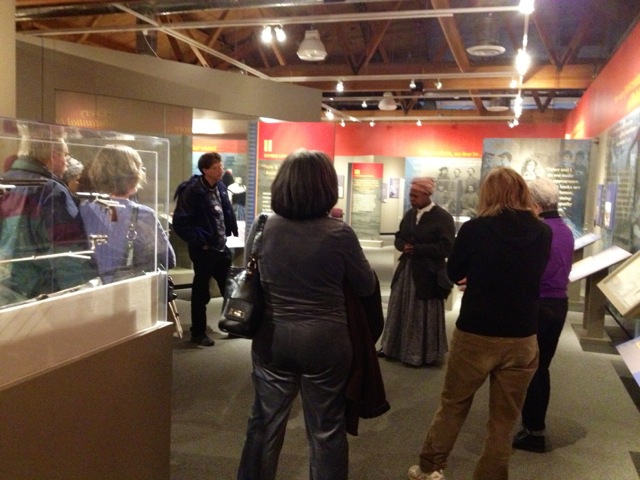by Harriet Lynn
Tour guides/docents are truly a museum’s “ambassadors”. They are the human interface between visitors to the collection, a special exhibit and/or to the institution itself. Imaginative interpretation is not just for children. Learning and applying museum theatre skills and techniques, visualization and/or storytelling methods the museum-goer can experience additional value while gaining a more personalized and memorable tour.
Introducing various creative methods (i.e., storytelling, living history, theatre and movement skills, visualization and/or improvisation) provide a pro-active tour experience. The visitor also enhances their own creativity and personal expression in their own right.
It encourages interpreters and educational staff to think, experiment and be “out-of-the- box” creatively applying the goals and mission of the institution. By training docents to invest in providing “storytelling” tours for adults, young adults and students, unique relationships can be established.
Guides/docents can also learn how to be comfortable in incorporating and building new ways of communicating within their own existing tours. Storytelling is a successful and personal methodology enabling visitors to be participating storytellers as well. The objects/art works become more meaningful and relevant by establishing a personal relationship in this circular “give and take” conversational manner.
Today’s museum-goers often want to be more engaged and be involved. Having a “tour guide skills tool box” can only add value, flexibility, and a help tours stay fresh and “new” each time. Finding meaningful and inventive ways to adapt for even challenging groups (i.e., hearing and sight impaired, Alzheimers/dementia individuals and their caregivers, etc.) becomes an opportunity to make the museum more alive for them.

Some Simple Tips and Thoughts for Museum Educators/Tour Guides
- You are the “Storyteller” speaking for the artist(s)/the artwork, and/or those who cannot speak for themselves.
- You are the messenger connecting to those who are present.
- Let the art/the history live!
- You are the “Ambassador” and the “Storyteller” of your museum/historic site.
- Objects/artifacts/pictures, etc. are used in context of the story you are weaving.
- You are taking visitors on a Journey.
- Plan ahead for what you want your group to take away with them.
- Avoid overloading with too many facts and figures. You can never tell it all anyway!
- Provide a “portal” for visitors to enter to learn more for themselves, if they desire.
- Give visitors at least that one special message that can be taken away with them they can always remember.
- Be respectful of visitor’s time, needs and other constraints! (i.e., including other venues and stops in a museum, in their day) and don’t forget to leave time for visitors to go to the museum store, too!
- Engage and be open for dialogue with visitors. Welcome their questions and thoughts.
- “Step into the shoes” of the art and the visitor and find the balance between the two.
- Give yourself and visitors permission to experience more of the collection and story in creative ways – and using your own creativity in your program(s).
- Let the object(s) speak to you and guide you in the telling of their story.
- Revisit your program and see where you can find places to bring creative spark.
- Use visitor surveys to provide direct feedback to see impact and how to enhance.

Harriet Lynn, BFA, MS is founder, producer and artistic director of Heritage Theatre Artists’ Consortium. Founded in 1994 Harriet Lynn has consulted and developed museum theatre, living history, oral history performance programs and/or docent training for museums, historical societies, educational institutions and museum conferences. She is a member of AAM, WMA and IMTAL (International Museum Theatre Alliance) with an extensive background in arts education and administration, professional theatre and dance.








Add new comment